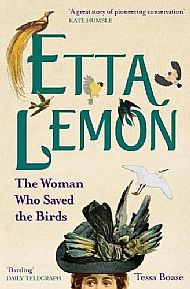THE LADIES WHO FOUNDED THE RSPB
Conflicting objectives of saving birds and of female emancipation.
The letters RSPB are so familiar to us today that we almost take them for granted. Something to do with the protection of birds... and the natural environment. But it originated through the disgust and concerns about the use of feathers in fashion!
The fight against this practice went on for years and was epic. Yet we are hardly aware of it. It came about almost concurrently with the Suffragettes and their campaign for votes for women. We remember the name of Emily Pankhurst. But the names of those who fought to stop the senseless use of bird feathers in vanity driven fashion have faded in time; outdone in the public consciousness.
The campaigns against the misuse of bird feathers in fashion not only ran alongside that of femail emancipation, but counter to it.
Even within the movement to save the birds there were conflicts of personalities and prejudices, including the prevailing thought that only men should lead such campaigns.
The RSPB's own website tells us more:
Campaigning for our natural world is a huge part of what the RSPB does today. But it’s also the reason we were created in the first place. It was Emily Williamson who started the Society for the Protection of Birds in 1889 after becoming sickened by the slaughter of exotic birds for their feathers. From the 1870s to the 1920s the fashion for feathers in ladies’ hats was huge and so many were being killed it was driving birds such as Little Egrets, Great Crested Grebes and birds of paradise towards extinction.
Emily, from Didsbury, Greater Manchester, was angry that the all-male British Ornithologist’s Union was doing nothing to protect these birds from becoming a fashion accessory. Others too were determined to protect wild birds from the whims of fashion, and Emily Williamson joined forces with Eliza Phillips of the Fur, Fin and Feather Folk of Croydon, Etta Lemon and Winifred Cavendish-Bentinck, Duchess of Portland.
Together the women started to campaign against this ‘murderous millinery’ and fought across many fronts. Emily used her wide women’s network to get hundreds of pledges to ‘Wear No Feathers’. Eliza became head of publications, writing dozens of hard-hitting pamphlets. She also masterminded the 1903 campaign to save species of egret from extinction in what became known as ‘The Frontal Attack’.
Etta, known as the ‘Mother of the Birds’ and ‘The Dragon’ was the dynamo behind the (R)SPB for its first half-century. She was a tenacious campaigner and would shame ‘feather bedecked women’ in church. She remained a passionate campaigner right up until her forced retirement at 80. Meanwhile the Duchess was a humanitarian aristocrat behind a number of good causes – from pit ponies, to girls’ education, to caged birds. She used her influence to press for change and was president of the RSPB for 60 years until her death. [RSPB].
A name mentioned above that should stand out more is that of one of the founding members, Etta Lemon. She, along with her husband as legal adviser, was a driving force for 3 decades, yet her name faded from prominence even within the RSPB. The Lemons led the RSPB for more than three decades, although Etta's conservatism, authoritarian management and opposition to scientific ornithology increasingly led to clashes with the organisation's committee. She was pressured to resign from her leadership role in 1938, aged 79. During her tenure, the Importation of Plumage (Prohibition) Act 1921 restricted the international trade in feathers, but did not prevent their being sold or worn. [Wiki].
It is ironic that one of the symbols of the Suffragettes, Emily Pankhurst's prominent purple feather in her stylish hat is, in retrospect, also one that symbolises terrible impact on birds, both in the UK and abroad.
Something else that is so often overlooked by the high fashion penchant for bird feathers, is that of the terrible worsking conditions of the many people at the lower end of the long processes to get them onto the hats of the women at the upper end. As Tessa Boase puts it, .... while Mrs Pankhurst's feather might not be, on the face of it 'murderous millinery', it still held in its fronds an invisible world of ruthless male commerce and exploited female labour. Mrs Pankhurst wore it as a political statement. It was how she nailed her colours to the mast. But it was also, ironically, an emblem of female abuse. [Boase].
BOASE, Tessa. ETTA LEMON - The Woman Who Saved the Birds. 2018. Aurum. ISBN 978 0 7112 6338 3

RSPB website - The woman who helped save more than a million birds : https://www.rspb.org.uk/about-us/how-it-started-the-female-campaigners-who-created-the-rspb
WIKIPEDIA : https://en.wikipedia.org/wiki/Etta_Lemon

